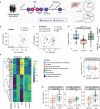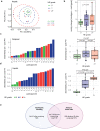Portosystemic shunt placement reveals blood signatures for the development of hepatic encephalopathy through mass spectrometry
- PMID: 37652904
- PMCID: PMC10471626
- DOI: 10.1038/s41467-023-40741-9
Portosystemic shunt placement reveals blood signatures for the development of hepatic encephalopathy through mass spectrometry
Abstract
Elective transjugular intrahepatic portosystemic shunt (TIPS) placement can worsen cognitive dysfunction in hepatic encephalopathy (HE) patients due to toxins, including possible microbial metabolites, entering the systemic circulation. We conducted untargeted metabolomics on a prospective cohort of 22 patients with cirrhosis undergoing elective TIPS placement and followed them up to one year post TIPS for HE development. Here we suggest that pre-existing intrahepatic shunting predicts HE severity post-TIPS. Bile acid levels decrease in the peripheral vein post-TIPS, and the abundances of three specific conjugated di- and tri-hydroxylated bile acids are inversely correlated with HE grade. Bilirubins and glycerophosphocholines undergo chemical modifications pre- to post-TIPS and based on HE grade. Our results suggest that TIPS-induced metabolome changes can impact HE development, and that pre-existing intrahepatic shunting could be used to predict HE severity post-TIPS.
© 2023. Springer Nature Limited.
Conflict of interest statement
Am.Z. is a co-founder, acting chief medical officer, and equity-holder in Endure Biotherapeutics. P.C.D. is a scientific advisor and holds equity to Cybele and a Co-founder, advisor and holds equity in Ometa, Arome and Enveda with prior approval by UC-San Diego and consulted in 2023 for DSM animal health. A.A.A. is a founder of Arome Science Inc. The remaining authors declare no competing interests.
Figures





Update of
-
Pre- and Post-Portosystemic Shunt Placement Metabolomics Reveal Molecular Signatures for the Development of Hepatic Encephalopathy.medRxiv [Preprint]. 2023 Jan 4:2023.01.02.22281374. doi: 10.1101/2023.01.02.22281374. medRxiv. 2023. Update in: Nat Commun. 2023 Aug 31;14(1):5303. doi: 10.1038/s41467-023-40741-9. PMID: 36711444 Free PMC article. Updated. Preprint.
References
-
- Madsen M, Kimer N, Bendtsen F, Petersen AM. Fecal microbiota transplantation in hepatic encephalopathy: a systematic review. Scand. J. Gastroenterol. 2021;56:560–569. - PubMed
-
- Wijdicks, E. F. M. Hepatic encephalopathy. N. Engl. J. Med. 10.1016/j.mcna.2008.03.009 (2016).
-
- Häussinger D, et al. Hepatic encephalopathy. Nat. Rev. Dis. Primer. 2022;8:43. - PubMed
-
- Sanyal AJ, Bosch J, Blei A, Arroyo V. Portal hypertension and its complications. Gastroenterology. 2008;134:1715–1728. - PubMed
-
- Nakamura T, et al. Physiologic measurement of intrahepatic shunted blood flow by means of D-galactose-1C14. Angiology. 1971;22:344–353. - PubMed
Publication types
MeSH terms
Substances
Grants and funding
- K08 DK113244/DK/NIDDK NIH HHS/United States
- R01 EB030134/EB/NIBIB NIH HHS/United States
- R01 HL148801/HL/NHLBI NIH HHS/United States
- I01 BX005707/BX/BLRD VA/United States
- UL1 TR001442/TR/NCATS NIH HHS/United States
- TL1 TR001443/TR/NCATS NIH HHS/United States
- P30 DK120515/DK/NIDDK NIH HHS/United States
- P30 DK063491/DK/NIDDK NIH HHS/United States
- R21 MH117780/MH/NIMH NIH HHS/United States
- K08 DK102902/DK/NIDDK NIH HHS/United States
- U01 CA265719/CA/NCI NIH HHS/United States
- P30 CA014195/CA/NCI NIH HHS/United States
- P50 AA011999/AA/NIAAA NIH HHS/United States
- R03 DK114536/DK/NIDDK NIH HHS/United States
LinkOut - more resources
Full Text Sources
Other Literature Sources

